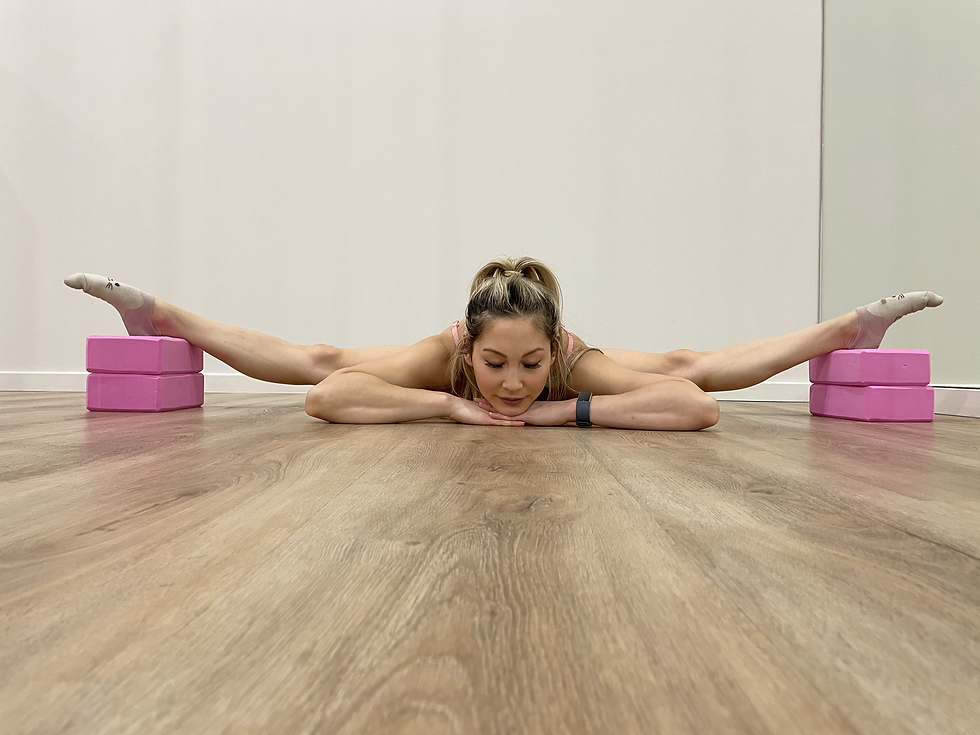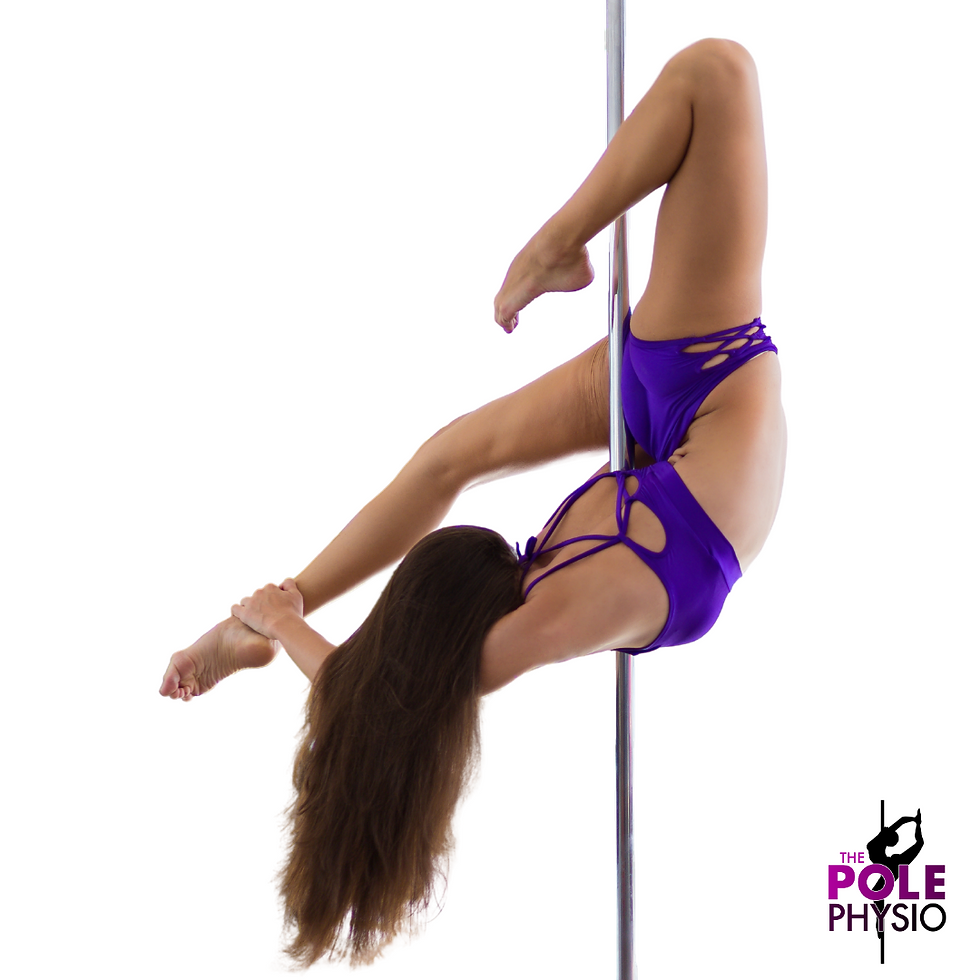Nerve vs muscle: What are we really stretching?
- Danielle Davey

- Dec 18, 2021
- 7 min read
Updated: May 20, 2023
How much do you think about WHAT you are feeling and WHERE you feel it when you stretch? It’s super important and we are going to look at why. Our focus will be on forward bending/hamstring mobility, but this information can be used for any part of the body. There are many structures that can contribute to (or hinder!) our mobility. All of them need to be moving well for us to be able to access a true muscular stretch.
Bones/joints
Nerves
Fascia
Muscles

What might we feel if we are trying to stretch muscles, but something else is getting in the way first? How many of these have you experienced?
Bones/ joints:
Compression or pinching on the opposite side of the body to where you are trying to stretch.
“Bone on bone” feeling.
Nerves:
Thin line of pull directly down the centre of the muscle. May go further than the actual muscle you are trying to stretch.
Tingling, pins and needles or numbness during or as you release a stretch.
Flare up of pain 1-3h after stretching (“latent pain”).
Fascia (connective tissue):
A broad feeling of stretch that isn’t isolated to the muscle you are trying to stretch. It may appear above or below what you are stretching.
Take note- it may be felt quite far away from where you expect- doing a forward bend, maybe you feel pulling in the upper back, behind the knees or in the calves.
Other signs you aren’t stretching what you’re trying to stretch:
Other areas of the body automatically move to compensate as you enter a stretch. Head may tip back, foot may be pulled in to a pointed position, spine may bend or twist.
Range of motion doesn’t get better after a stretch, or may get worse.
And what DO we want to feel when stretching a muscle?
We should feel a broad stretch across the belly of that one muscle. That’s all! It should feel good afterward and improve your range of motion immediately (i.e. it should be effective).
Does it matter what I’m stretching?
Yes! Absolutely! Conventional stretching only works for muscles. If you are trying to do a hamstring stretch when your sciatic nerve, for example, is limiting you, you will not get the desired effect and may end up with pain, injury or making your flexibility worse instead of better.
Let’s dive in to some anatomy to find out why that is!
Muscles
Skeletal muscles (muscles that move our body/skeleton) are made up of contractile fibres, meaning they can contract to shorten. In reverse, if muscles can contract, this also means they can relax, lengthen or stretch. There are a variety of stretching techniques that work well to help muscles lengthen, which we will all be familiar with to some degree.
Nerves
Nerves are robust, ropy, sliding structures. The nervous system is a continuum that connects from the brain, down the spinal cord and out in to the periphery (body). Many people don’t realise that nerves do not stretch like muscle does. This is because they are not contractile.
Like a power cord, nerves are thick and bendy, but they do not lengthen or stretch when pulled on. At rest, there is some extra length, like an extra coil or two in your vacuum cleaner cord. When we stretch and bend, the nerve slides and glides between our other tissues to allow us freedom of movement- like the vacuum cord uncoiling.
Just as the vacuum cord can get caught on pieces of furniture and stop you from reaching any further, so can a nerve. Many tissues in the body can catch the nerve, creating an anchor point. If I catch my vacuum cord under a table leg, no matter how much length was left on the other side of that anchor point, I will only be able to move as far as the length that is on my side. Nerves move the same way. If they aren’t sliding, you aren’t moving!
Fascia
Fascia is a complex and rapidly growing topic. Much of what was previously taught on fascia is now quite out dated and is perhaps not the most accurate. Keep an eye out for a full blog on this in the future, but here is a taster ;).
Fascia is often described as our body’s connective tissue. It can be thought of as the organ of posture. It is a white, spider web/sausage casing type structure, which connects and gives form to everything in the body.
Key points on fascia for mobility:
Fascia connects chains of muscles together to form pathways that work together in systems. These are frequently referred to as Anatomy Trains or fascial lines. This is a real Google rabbit hole for anyone interested in learning more!
It is in a constant state of remodelling and change. This is a very good thing when we are interested in mobility- if we nourish and treat our fascia well, it will love us back and enhance our mobility.
The properties of fascia depend on what we do to it. When strongly pulled on (stretched), it will resist, trying to protect us. If heavily pushed on, it becomes rigid and less hydrated. When gently and mindfully mobilised and glided, it will move, give and adapt, which we can use to our advantage. When well hydrated and nourished with steady, purposeful movements, it is highly adaptable and can reorganise to allow us increased mobility immediately and over time.

So what happens if I’m not stretching what I think I’m stretching?
If you are trying to stretch a muscle but nerve, joint or fascia are getting in the way, a variety of things may happen, depending on what structures you are loading. Suffice to say that your mobility will not improve as you expect and deserve from all your hard work!
How can I work out what is limiting me?
1. Symptoms: listen to your body.
Put your hands on your body and describe with hands and words WHAT and WHERE you feel the “stretch”.
Is there compression or pinching in the joint? This will not stretch out and you may end up causing yourself an injury. Get checked by a pole/dance trained therapist.
A thin line of pull that you can trace along the limb? Most likely to be neural restriction.
Pins and needles, numbness or tingling during or as you exit a stretch? Most likely neural restriction. Possibly loss of circulation.
Latent pain 1-3h after? Most likely neural restriction.
A broad, sweeping pull along an area? Usually gestured with the flat of your hand moving up and down the area. Not limited to the muscle you were trying to stretch- often above, below or both. E.g. behind the knee or in the calf when hamstring stretching. Fascial restriction.
Clapping the hands straight on to the centre of the muscle bulk? Congratulations! This is a true muscle stretch!
2. Test your nerve mobility
Slump test:
Process:
Curl the spine & tuck in the head
Straighten the leg keeping the toes points
Flex the foot
Lift the head
Take note of any stretching sensation throughout and if it is eased when the head lifts
If the stretch eases when the head lifts up, then this is a nerve stretch that you experienced and it may be limiting your movement.
Dancer's slump test:
Process:
Curl the spine & tuck in the head
Flex the foot
Lift the head
Take note of any stretching sensation throughout and if it is eased when the head lifts
If the stretch eases when the head lifts up, then this is a nerve stretch that you experienced and it may be limiting your movement.
3. Test and retest your mobility
Conventional “stretches” such as a forward fold or the splits are our end goals right? Take a photo/video, take a measurement and also note how they feel. Do a stretch, mobilisation, release or other technique, then re-test. Was there improvement? Did your technique work? If there is no change, it isn’t the technique for you right now.
4. Seek professional help!
While this is often beyond the scope of a regular therapist, a dance, pole or circus trained therapist will be your best friend in helping you decipher your body. We don’t just mop up the mess when you injure yourself- we are a knowledge base on understanding your individual body and helping you move better.
Ways to improve your neural mobility (sciatic edition)
Find lock points and gently work on them:
Suboccipital release with ball
Piriformis release with ball
Thoracic release with peanut/ 2 balls
Nerve sliders
Check our social media for this week to see how to do these. Technique is important and they should be done with care.
How to put this in to your weekly training schedule
Take time at home to work out your limiting factors. If muscular, great.
If neural: Take 5min before doing any class based flex work to unlock your neural mobility BEFORE stretching. Don’t rely on your teacher to know whether you are stretching a muscle or a nerve (they can’t feel what you feel!) Know or test in advance to get more out of your classes.
Be aware of your body during training. If you are mid class and start to feel you are being limited by nerve mobility, take a quick break to free up the nerve, then keep going. Don’t push through- you may be very sore tomorrow, risk injury and won’t get as much out of your trick/stretch.
We hope this blog has opened your mind a bit on taking note of what you feel and where you feel it when you stretch. Take this as your cue to go forth and be curious about your body, how it moves and how you might be smart about improving your mobility. It will save you a great deal of time and pain to work with each of your body’s tissues as they crop up.
A final note, if you would like to delve one step further… once you’ve worked out WHAT is limiting you, for bonus points think about WHY was that tissue like that in the first place? Working this out will save you time from having to go back and re-release things every time you want to stretch.
Wanting to get to the crux of what is limiting your forward fold and split flexibility?
Online telehealth appointments can be booked with the Pole Physio via our ‘Book Online’ page that can be found here. Assessment and tailored rehabilitation are provided in accordance with best practice and evidence-based treatment to help you unleash your 'poletential'.
Until next time, train safe
The Pole Physio
x

























Wakad Wagholi Viman Nagar Vishrantwadi Shivajinagar SB Road Ravet Pune best city Pimple Saudagar Pirangut Marunji Nigdi Pashan Pimpri Chinchwad Magarpatta Lohegaon Koregaon Park Kalyani Nagar Kharadi Pune city Service Pune Star Hotel Hinjewadi Pune desire Pune Airport city Akurdi Aundh Balewadi Baner Bavdhan Bhumkar Chowk Pune city Chakan Dehu Road Deccan Gymkhana Dhanori best city
XY miner XY miner
cesur mining cesur mining
block chain cloud mining…
block chain cloud mining…
block chain cloud mining…
xy miners xy miners
rich miner rich miner
savvy mining savvy mining
xy miners xy miners
savvy mining savvy mining
savvy mining savvy mining
XY miner XY miner
cesur mining cesur mining
block chain cloud mining…
block chain cloud mining…
block chain cloud mining…
xy miners xy miners
rich miner rich miner
savvy mining savvy mining
xy miners xy miners
savvy mining savvy mining
savvy mining savvy mining
XY miner XY miner
cesur mining cesur mining
block chain cloud mining…
block chain cloud mining…
block chain cloud mining…
xy miners xy miners
rich miner rich miner
savvy mining savvy mining
xy miners xy miners
savvy mining savvy mining
savvy mining savvy mining